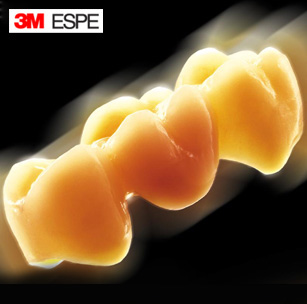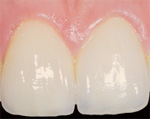
Lava Zirconia Crowns & Bridges
What materials can be used for a restoration?

Metal
Alloy of metals with either silver or gold appearance. Does not mimic look of real teeth. The traditional restoration used for decades.

Porcelain-Fused-To-Metal
Porcelain, fused to an underlying metal structure. Comes closer to the look of real teeth than metal restorations. Metal substructure limits translucency sometimes resulting in restorations looking dull and lifeless.

Zirconium Oxide
Achieves the beauty and translucency of natural teeth. Produces strong, durable restorations. Could be an alternative for those who have concerns about metal.
Lava™ Crowns and Bridges.
Natural beauty that brings out the same in you.
- Lava™ Zirconia restorations are an ideal alternative to porcelain-fused-to-metal (PFM) restorations
- Lava zirconia restorations provides the translucency and beauty of your natural teeth
- Lava zirconia could be an alternative for those who have concerns about metal
Lava™ Crowns and Bridges.
An investment that helps you live comfortably.
- Precision computer design ensures Lava restorations fit well, and feel comfortable
- 3M ESPE is committed to providing materials and solutions that are safe and effective for use.
Lava™ Crowns and Bridges.
Beauty that lasts like no other restoration.
|
|
Lava Zirconia Crowns and Bridges
3M™ ESPE™ Lava™ Zirconia
Your teeth play an important role in your overall health as well as your appearance. So, naturally, you want to do everything you can to keep them healthy and looking good. Sometimes, however, tooth decay advances to a point where a tooth is too weak to survive with just a direct restoration or filling.
Instead, your dentist may recommend an indirect restoration, also known as a crown or bridge. In these cases, the decayed area is removed and the restoration is fitted over the original tooth. This is a step that can help preserve the health and appearance of your smile. The evolution of restorations.

Traditionally, crowns and bridges were made of metal, because it is strong and relatively inexpensive. Then came porcelain fused to metal restorations, which came closer to the look of real teeth and provided strength, durability and fit.
But it is difficult to achieve the translucency of your natural teeth with a restoration that has a metal framework. Light does not pass through the metal restoration like it does through your own teeth, leaving a dull, lifeless appearance. In addition, over time, the metal framework can leave a dark ridge where the gums recede.

Today, there’s a solution as beautiful as nature itself: 3M™ ESPE™ Lava™ Zirconia restorations. Lava Zirconia offers the benefits of porcelain fused to metal — strength and longevity.
Just as important, Lava zirconia restorations can be matched precisely to the color of your own teeth and provide the natural translucency that metal-based restorations can’t.
How Lava Zirconia Restorations are made
To make a Lava™ crown or bridge, your dentist will take an impression of your mouth, and send it to a laboratory. There, a technician, using computer-aided design technology, will use the impression to create a model of your mouth. After creating a precise framework for your restoration, a dental technician will build up layers of ceramic onto the framework so that the final restoration will match your natural teeth. The completed restoration will then be delivered to your dentist who will fit it for you. Ask Abington Dental staff to tell you more.
Your smile deserves something more precious than metal. Bring out the natural beauty in your smile and ask your dentist about Lava restorations — the brand of zirconia most asked for by dentists.
You need a restoration. So what is a restoration?
An indirect restoration, also called a crown or bridge, is used to cover or replace a tooth that is broken, discolored, badly shaped or has too much decay for a filling.
- The restoration is fitted over the original tooth after any decay has been removed.
- The right restoration will look, feel and last like your natural teeth.






